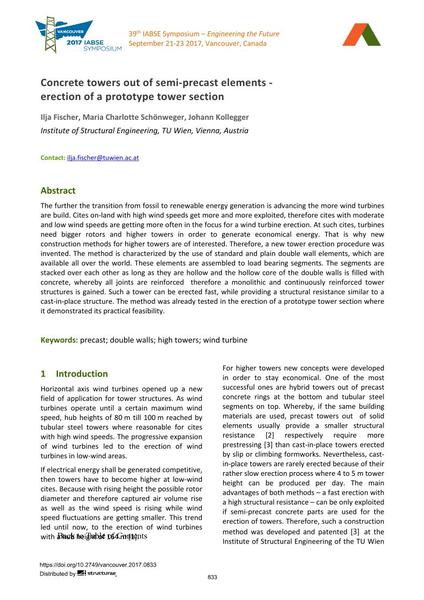Concrete towers out of semi-precast elements - erection of a prototype tower section

|
|
|||||||||||
Bibliographic Details
| Author(s): |
Ilja Fischer
(Institute of Structural Engineering, TU Wien, Vienna, Austria)
Maria Charlotte Schönweger (Institute of Structural Engineering, TU Wien, Vienna, Austria) Johann Kollegger (Institute of Structural Engineering, TU Wien, Vienna, Austria) |
||||
|---|---|---|---|---|---|
| Medium: | conference paper | ||||
| Language(s): | English | ||||
| Conference: | IABSE Symposium: Engineering the Future, Vancouver, Canada, 21-23 September 2017 | ||||
| Published in: | IABSE Symposium Vancouver 2017 | ||||
|
|||||
| Page(s): | 833-837 | ||||
| Total no. of pages: | 5 | ||||
| Year: | 2017 | ||||
| DOI: | 10.2749/vancouver.2017.0833 | ||||
| Abstract: |
The further the transition from fossil to renewable energy generation is advancing the more wind turbines are build. Cites on-land with high wind speeds get more and more exploited, therefore cites with moderate and low wind speeds are getting more often in the focus for a wind turbine erection. At such cites, turbines need bigger rotors and higher towers in order to generate economical energy. That is why new construction methods for higher towers are of interested. Therefore, a new tower erection procedure was invented. The method is characterized by the use of standard and plain double wall elements, which are available all over the world. These elements are assembled to load bearing segments. The segments are stacked over each other as long as they are hollow and the hollow core of the double walls is filled with concrete, whereby all joints are reinforced therefore a monolithic and continuously reinforced tower structures is gained. Such a tower can be erected fast, while providing a structural resistance similar to a cast-in-place structure. The method was already tested in the erection of a prototype tower section where it demonstrated its practical feasibility. |
||||
| Keywords: |
wind turbine precast double walls high towers
|
||||
